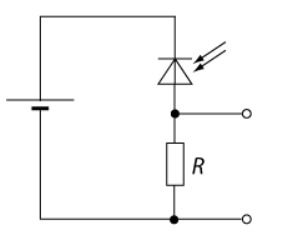Optical Sensor for Noise Flickering
Group Members
Eric Cheung Jun Hao; Lee An Min, Amanda; Loh Jia Ying Whitney
Background and Introduction
The objective of this project is to characterise a given photodiode and to successfully determine the frequency of an unknown flickering light source.
With a simple potential divider, consisting a resistor and a photodiode in series, the resistance and hence sensitivity of the photodiode can be determined. By exposing the photodiode to visual noise tags, such as the flickering of LEDs, the resistance across the photodiode is expected to decrease and hence, a larger potential can be measured across the resistor. The photodiode resistance is a function of light exposure. The resistance is inversely proportional to light intensity. The output can be observed on an oscilloscope to determine the performance of the photodiode.
Set-Up
Equipment Needed
| S/N | Item | Description/Model No. |
|---|---|---|
| 1 | Soldering Iron | - |
| 2 | Soldering Tin | - |
| 3 | Wires | - |
| 4 | Resistors | 10k, 100k, 500k, 1M, 10M |
| 5 | LDR Photoresistor | GL5528 / GL5537 |
| 6 | DC Power Supply | Matrix MPS-3005L-3 |
| 7 | Signal Generator | Agilent 33220A |
| 8 | 40 MHz Analog Oscilloscope | Hameg HM400 |
| LED S/N | Colour | Wavelength (nm) | Size (mm) |
|---|---|---|---|
| 1 | Red | 643 | 5 |
| 2 | Orange | 625 | 5 |
| 3 | Amber | 605 | 5 |
| 4 | Green | 570 | 5 |
| 5 | Blue | - | 5 |
| 6 | Red | 650 | 3 |
| 7 | Orange | 625 | 3 |
| 8 | Green | 570 | 3 |
| 9 | Blue | - | 3 |
Experimental Set-up
Circuit Design
A signal generator is used to pulse the LEDs to create a flickering light source. A square wave with a peak-to-peak voltage of 2V is used across all the measurements taken. A DC power supply is used to supply 3V across the photodiode.
Variables
The performance of the photodiode will be determined by varying the following parameters: 1. Wavelength of LED 2. Resistor in circuit 3. Frequency of blinking (1Hz - 100kHz)
The dependent variables that will be measured are: 1.
This will allow us to determine the following parameters: 1. Efficiency (Time decay) of photodiode at different wavelengths
Timeline and Milestone
| Week | Dates | Tasks |
|---|---|---|
| Week 7 | 4 - 8 Mar | Collecting equipment and prelimary set-up |
| Week 8 | 11 - 15 Mar | Complete circuit set-up and prelimary measurements |
| Week 9 | 18 - 22 Mar | Data collection (vary LEDs) |
| Week 10 | 25 - 29 Mar [Well-being day (28 Mar), Good Friday (29 Mar)] | Data collection (vary resistance) |
| Week 11 | 1 - 5 Apr | Data Analysis and further measurements (if needed) |
| Week 12 | 8 - 12 Apr [Hari Raya (10 Apr)] | Data Analysis and explore other light sources (phone/computer screens) |
| Week 13 | 15 - 19 Apr | Analyse experimental results and complete documentation |
Results
Characterisation of the photodiode is done with three 5 mm LEDs: (i) red, 643 nm; (ii) green, 570 nm; and (iii) blue, 450 nm to 495 nm. It can be noted that the photodiode sensitivity increases with increases wavelength of LED used. The photodiode used in this experiment is Hamamatsu S5972 Si PIN photodiode, with a peak sensitivity of 0.57 at wavelength of 800 nm. According to the datasheet, sensitivity decreases as wavelength decreases. This matches our experimental results.
